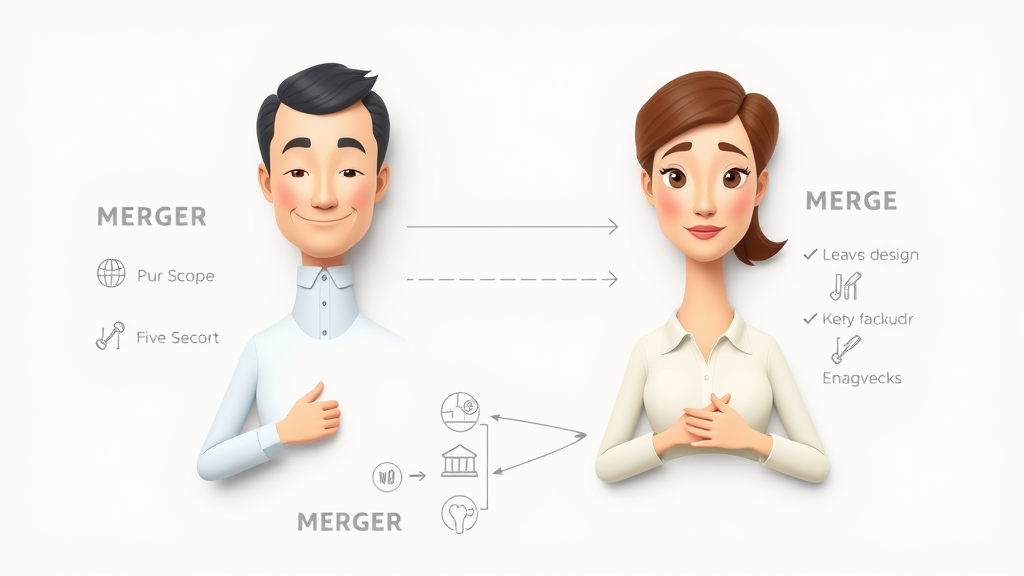'Up to 90% of mergers and acquisitions fail to deliver the anticipated value—but understanding the right strategies can turn the odds in your favor.'
Unlocking Success in Mergers and Acquisitions: Why Mastery Matters
Did you know that nearly 90% of mergers and acquisitions (M&A) fall short of delivering their expected value? For companies eager to grow, this statistic is a wake-up call—mastering the art and science of M&A is both a challenge and an opportunity. In today’s competitive landscape, every leader must understand the mechanics, risks, and powerful advantages that come with combining organizations.
Whether you’re contemplating your first deal or seeking to refine your strategy, understanding the intricate details of mergers and acquisitions can put you—and your company—at the front of the pack. This guide will demystify complex M&A terms, explain key concepts like cash flow and tender offers , and break down the difference between friendly and hostile takeovers . You’ll also get actionable advice from real-world examples and expert-approved strategies to minimize risk and maximize value. Get ready to master the M&A game.

- Critical concepts in mergers and acquisitions
- Major types and structures of M&A
- Expert tips to ensure successful deals
- Strategies to mitigate M&A risks
- Real-world examples and actionable advice
Understanding Mergers and Acquisitions: Foundations and Definitions
Defining Mergers and Acquisitions: Core Principles
Mergers and acquisitions refer to the various ways companies combine to form a single organization or transfer ownership of significant assets. In a merger , two companies agree to move forward as a single entity, usually with the goal of leveraging economies of scale , increasing market share , and enhancing competitiveness. In contrast, an acquisition occurs when one company—the acquiring firm —takes control of another, which becomes the target company .
These transactions can be friendly or hostile , depending on whether a board of directors and shareholders consent to the deal. M&As involve transferring assets and liabilities , integrating customer bases , reshaping business operations , and evaluating the true worth of both entities, often with the support of investment banks . The process is complex but essential for companies aiming to improve their strategic position and drive long-term growth.
Why Companies Pursue Mergers and Acquisitions
Businesses embark on mergers and acquisitions for a range of strategic reasons. Some seek to increase their market share or expand their customer base . In other cases, acquiring new capabilities, streamlining the supply chain , or securing valuable intellectual property moves companies closer to their goals. For example, a horizontal merger might help consolidate a fragmented industry, while a vertical merger can improve efficiency by controlling more parts of the production process.
Sometimes, the motive behind an acquisition is to enter new geographic markets, eliminate competition, or quickly gain new technology. In the United States and worldwide, companies also use M&A as a way to transform their business models and outpace rivals. Whether pursuing a reverse merger to become a publicly listed company or leveraging an asset purchase strategy, successful deals require clear objectives and solid expertise.

Recent Trends in Mergers and Acquisitions
The last decade has reshaped mergers and acquisitions in profound ways. Globalization, digital transformation, and increased cross-border transactions have led to larger and more complex deals. Since 2020, there’s been exceptional growth in private equity participation, as investors seek to capitalize on undervalued targets and volatile markets.
Another notable trend is the rise in reverse mergers , where private companies merge into publicly listed shell companies to gain quicker market access. Deals are also being driven by a quest for digital assets , supply chain resilience, and rapid expansion into emerging markets. These dynamic trends highlight how critical adaptability and deep strategic insight are for achieving successful outcomes in today’s M&A landscape.
Exploring the Major Types of Mergers and Acquisitions
Horizontal, Vertical, Conglomerate, and Market-Extension M&A
There are four major categories of mergers and acquisitions : horizontal , vertical , conglomerate , and market-extension deals. Horizontal mergers occur between companies in the same industry and at the same stage of production, often seeking to enhance market share and achieve horizontal integration . Vertical mergers involve businesses at different stages of the supply chain , providing benefits like reduced costs and increased control over the flow of goods.
Conglomerate mergers combine companies from unrelated industries, helping diversify business risk. Market-extension mergers are centered on product or market expansion, allowing a company to offer the same products to new markets or new products to existing markets. Each type caters to unique strategic objectives and comes with varying challenges, regulatory implications, and integration needs—making it essential to choose the correct structure for your business goals.

Private Equity’s Role in Mergers and Acquisitions
Private equity firms have become major players in the mergers and acquisitions field, providing financing, strategic direction, and operational know-how. These investors typically acquire controlling stakes in target companies with the intention of improving performance, implementing new management, and selling the business at a higher value.
In addition to standard M&A activity, private equity groups often pursue asset purchases —acquiring parts of a business rather than the entire company—allowing for greater flexibility and risk mitigation. Their involvement has transformed M&A by introducing more disciplined valuation methods, aggressive performance targets, and an increased focus on post-deal integration.
| Type | Structure | Example Deal | Strategic Goals |
|---|---|---|---|
| Horizontal | Merge with a competitor in the same industry | Disney & Pixar | Increase market share, economies of scale |
| Vertical | Combine with supplier/distributor | Amazon & Whole Foods | Control supply chain, reduce costs |
| Conglomerate | Merge with unrelated business | Berkshire Hathaway & GEICO | Diversification, risk reduction |
| Market-Extension | Combine to access new markets | Heinz & Kraft | Expand reach, new customer base |
Expert Strategies for Successful Mergers and Acquisitions
Due Diligence: The Pillar of M&A Success
Due diligence is the most critical phase of any mergers and acquisitions transaction. This process involves an in-depth assessment of the target company’s financials, operations, legal standing, contracts, and organizational structure. A thorough review safeguards the acquiring company against unpleasant surprises and helps determine the right purchase price .
Companies should scrutinize assets and liabilities , evaluate the cash flow , and review key documents such as customer and vendor agreements. With the help of private equity experts, investment banks, and specialized advisors, due diligence ensures all aspects—operational, financial, legal, and cultural—are carefully analyzed. This careful approach minimizes risks that can derail a deal and sets the stage for post-merger value creation.
For those looking to go beyond the fundamentals and secure the most favorable terms, exploring practical approaches to business acquisition can provide a tactical edge. Discover actionable steps and negotiation insights in this guide to sealing the best business acquisition deals .

Valuation Methods in Mergers and Acquisitions
Determining the right valuation method is essential for both sellers and buyers in any merger or acquisition . The most common approaches include the Discounted Cash Flow (DCF) analysis, comparable company analysis , and the precedent transactions method . Each approach uses different metrics to establish an accurate estimate of the target firm’s worth. For instance, DCF focuses on forecasting future cash flows to arrive at a present value, while comparable company analysis looks at industry peers to set benchmarks.
The choice of valuation method depends on deal context, industry norms, and available data. Overvaluation or undervaluation can hinder long-term success, making independent verification and consultation with investment banks or advisors crucial. With expert guidance, shareholders of the acquiring or target company can make informed decisions, reducing the likelihood of buyer’s remorse.

Integrating Cash Flow Analysis for Smarter Decisions
Evaluating cash flow is at the heart of assessing any M&A opportunity. Whether you’re a private equity firm or a corporate investor, projecting the target company’s cash-generating potential highlights both opportunities and red flags. An in-depth analysis provides clarity on the ability of the combined entity to support operations, service debt, and fund future growth.
Smart M&A practitioners don’t stop at historical cash flow; they look ahead, incorporating factors such as operational synergies, anticipated cost savings, and shifts in revenue streams. When rigorously applied, cash flow analysis can differentiate between a promising acquisition and a risky gamble, safeguarding stakeholder interests and paving the way for sustainable success.
Understanding Hostile Takeovers and Tender Offers in Mergers and Acquisitions
How Hostile Takeovers Unfold in Mergers and Acquisitions
A hostile takeover occurs when an acquiring company attempts to gain control of a target company without its board’s consent. These aggressive strategies often play out when a target’s management resists the deal, yet the acquirer believes the transaction will enhance market share , business operations, or access to unique assets. Hostile takeovers in the United States and abroad can be executed through direct appeals to shareholders or via accumulated stock purchases in the open market.
Defenders can deploy various counter-measures, including "poison pills" or seeking a more favorable buyer (a "white knight"). Hostile takeovers are high-stakes, carrying risks ranging from cultural clashes to value destruction if not managed carefully. Successful outcomes require not just legal expertise, but also careful planning, negotiation skills, and the ability to gain shareholder trust.

Tender Offer Strategies and Outcomes
A tender offer is a public bid to buy a significant portion of a company's shares directly from shareholders, typically at a premium above the current market price. This strategy often accompanies hostile takeovers but can also be used in friendly acquisitions. The acquiring firm typically sets a minimum number of shares it must obtain for the offer to be valid, providing incentives for shareholders to sell.
Tender offers are governed by strict securities regulations to protect all parties. In the process, swift communication, transparent information, and the right premium can sway even hesitant investors. Understanding tender offers is crucial for both acquiring companies and shareholders, as their acceptance can rapidly change the control structure and direction of the target company.
Minimizing Risk During Mergers and Acquisitions
Common Pitfalls and How to Avoid Them
Even the most promising M&A deals can unravel if common mistakes aren’t identified early. Integration failures, poor cultural alignment, hidden liabilities, and overestimating synergies contribute to the up-to-90% failure rate. One classic error is neglecting detailed due diligence—overlooking critical data in assets and liabilities , cash flow , or legal contracts of the target company. Another frequent issue is underestimating the complexity of merging business operations and integrating different customer bases.
To minimize risk, companies should implement robust risk assessment protocols, involve experienced advisors, and develop clear post-merger integration plans. Regular communication across teams and careful management of stakeholder expectations can prevent value erosion and ensure that integration delivers on strategic objectives.

Creating Value Beyond the Deal
The end of a merger or acquisition is just the beginning of value creation. — M&A Industry Leader
Real value from mergers and acquisitions is realized only after the deal is done. Post-merger integration demands attention to IT systems, talent retention, and aligning corporate cultures. Companies need to quickly deliver promised synergies, such as cost savings, expanded customer base, enhanced supply chain, and streamlined business operations.
By focusing on transparent communication, ongoing performance monitoring, and continuous adaptation to market shifts, organizations can unlock the full potential of their new structure. A proactive approach to change management ensures not only short-term gains but also lasting strategic advantages.
Case Studies: Notable Mergers and Acquisitions and Their Outcomes

- Facebook’s acquisition of WhatsApp: Rapidly expanded Facebook’s global customer base and strengthened its position in the digital communications market.
- Disney’s acquisition of Marvel: Created lucrative new content streams, enabling Disney to dominate pop culture and drive multibillion-dollar box office returns.
- Kraft and Heinz merger: Combined two iconic food brands for greater market reach and supply chain efficiencies, underpinned by private equity leadership.
- AOL and Time Warner merger: Served as a cautionary tale about cultural misalignment and integration failures overshadowing initial strategic intent.
These case studies provide valuable lessons: while well-planned mergers and acquisitions can yield tremendous benefits, lack of integration or unclear vision can lead to missed opportunities or even financial loss. Analyzing both successes and failures is crucial for those looking to improve their own strategies.
Assessing Your Mergers and Acquisitions Readiness: Questions Every Business Leader Should Ask
- Is the company’s cash flow stable?
- Are due diligence protocols in place?
- Is there a post-merger integration plan?
- Have stakeholder interests been factored in?
These questions are critical checkpoints before pursuing any deal. Stable cash flow ensures your company can weather unexpected costs, while rigorous due diligence uncovers potential risks. A solid integration plan aligns teams and processes post-transaction, and stakeholder alignment smooths the path to long-term value creation. Taking the time to answer these questions honestly sets the foundation for M&A success.
People Also Ask: Insights into Mergers and Acquisitions
What is meant by mergers and acquisitions?
Mergers and acquisitions (M&A) refer to the process where two companies combine to form a new entity (merger) or one company purchases another (acquisition). These deals can be pursued for strategic reasons, such as expanding market share, accessing new customer bases, streamlining operations, or securing vital assets. M&A transactions can be friendly or hostile and involve complex steps, from initial discussions to post-transaction integration.
Is M&A a good career?
A career in M&A offers fast-paced, challenging, and highly rewarding experiences. Professionals in this field—often working at investment banks, consulting firms, or within corporate development teams—develop expertise in financial analysis, deal structuring, negotiation, and strategy. While the hours can be long, the compensation and career growth prospects are strong, particularly for those who excel at managing complex transactions and working well under pressure.
What are the 4 types of M&A?
The four main types of mergers and acquisitions are horizontal, vertical, conglomerate, and market-extension. Horizontal mergers combine companies in the same industry, vertical deals align firms at different supply chain stages, conglomerate mergers unite unrelated businesses, and market-extension moves help companies enter new markets or product lines. Each type has unique goals, benefits, and challenges.
Why do up to 90% of mergers and acquisitions fail?
Most M&A deals fail due to poor integration, cultural clashes, inadequate due diligence, or unrealistic expectations. Common mistakes include overestimating synergies, neglecting risk assessment, or not having a well-defined post-merger plan. Success demands solid execution, active leadership, and continuous communication throughout the process.
Answers to Frequently Asked Mergers and Acquisitions Questions
What are the main stages of an M&A deal?
The main stages include strategy development, target identification, due diligence, valuation and deal structuring, negotiation, agreement signing, and post-merger integration. Each phase involves detailed planning, analysis, and careful execution to minimize risks and achieve business objectives.
How long do mergers and acquisitions take to complete?
Most deals take six months to over a year, depending on their complexity, regulatory requirements, and the degree of due diligence required. Delays can occur if integration issues arise or if regulatory agencies require additional information or approvals.
What role does private equity play in mergers and acquisitions?
Private equity firms act as acquirers, financiers, or facilitators in M&A transactions. They provide capital, strategic oversight, and operational expertise, aiming to enhance the value of target companies for future sale or public offerings.
How are tender offers structured?
Tender offers are typically public proposals to buy significant shares of a target firm directly from its shareholders, often at a premium. The offers specify the price, time frame, and minimum number of shares required for the transaction to be successful, complying with securities laws to protect investors.
What are the signs of a potential hostile takeover?
Warning signs include sudden stock accumulation by outsiders, unfavorable management decisions, shareholder unrest, and unsolicited acquisition bids. Companies may employ defensive tactics, but early detection and proactive communication with stakeholders can deter hostile attempts.
Advancing in Mergers and Acquisitions: Next Steps for Success
- Ready to master mergers and acquisitions? Apply these expert tips, seek guidance from experienced advisors, and take your M&A strategy to the next level.
Strategic preparation, expert guidance, and proactive value creation are your keys to mastering the world of mergers and acquisitions.
As you continue to refine your M&A approach, it’s valuable to stay informed about the broader regulatory and market forces shaping major deals. For a deeper understanding of how high-profile mergers are influenced by public and governmental input, explore the evolving landscape through the lens of the Chevron Hess merger and the FTC’s decision-making process . Gaining perspective on these strategic developments can help you anticipate challenges, adapt your strategy, and position your organization for long-term success in the ever-changing world of mergers and acquisitions.
Sources
- https://www.investopedia.com/terms/m/mergersandacquisitions.asp – Investopedia
- https://hbr.org/2016/07/why-do-so-many-mergers-fail – Harvard Business Review
- https://corpgov.law.harvard.edu/2021/01/25/2020-ma-year-in-review/ – Harvard Law School Forum
- https://www.mckinsey.com/capabilities/strategy-and-corporate-finance/our-insights/the-seven-types-of-mergers-and-acquisitions – McKinsey & Company
- https://www.pwc.com/gx/en/services/deals/library/ma-industry-trends.html – PwC
 Add Row
Add Row  Add
Add 




Write A Comment